Have you ever run a trotline, or chased a jug as it dips and dances from the pull of a big fish? If not, you are missing out on a great way to introduce kids to fishing, have fun with family and friends, and enjoy a great meal of fresh catfish, too.
When most people talk fishing, they talk rods, reels, jigs, and plugs. But there’s another style of catfishing, by alternative methods, that is unlike any other. In regard to catching catfish, this means limb lines, jug lines, trotlines, throwlines, and bank lines. (See fishing methods in Chapter 6 of the Wildlife Code). With these methods, the line and hooks are attached or fixed in place and left overnight or fished in one area for an extended period of time. The only exception is jug lines that can either be anchored or free floating. You should take note that in all of these methods, gear must be attended at least once every 24 hours with the exception of floating jug lines, which must be attended at all times on streams and at least once per hour on lakes. All gear must also be labeled with your full name and address or Conservation ID number.
Getting Started
Trotlines
Trotlines come in many forms. Trotlines have one or both ends tied to a fixed object.
They can be tied between two trees, or with one end attached to a tree or large rock on the bank and the far end weighted in the water.
A trotline is made up of one main line and a series of dropper lines with hooks. The main line needs to be heavy enough to handle more than one fish. The dropper lines, sometimes called stagings, hold the hooks. Braided nylon line works best and won’t unravel like other lines. Main lines in the range of #24 (210-pound test) and dropper lines around line #18 (165-pound test) are heavy enough for multiple large catfish.
The main line is stretched horizontal and the dropper lines hang vertical from the main line. Dropper lines are required to be spaced no less than two feet apart from each other along the main line. You’ll want to keep droppers this far apart, otherwise two fish next to each other can make a real tangled mess. It’s best to attach the dropper line to the main line with a heavy barrel swivel. Some catfish, especially blues, will twist and roll once they are hooked. Trotlines can be marked using a 2-liter soda bottle, or something similar, tied to the main line.
Jug Lines
Jug lines are another great method to catch catfish. You’ll need to start with some type of large float or “jug.”
Floats are commonly made from swim noodles or large bottles, like a 2-liter soda bottle. You’ll want to use a jug large enough to provide resistance when a fish bites. This increases the odds of a good hook set. Brightly colored jugs are easier to see. Road-construction orange, bright yellow, and white work well.
Standard swim noodles can be cut into two or three sections. Most noodles are hollow in the middle. You can use a length of ½- or ¾-inch PVC pipe through the center of the noodle. This will make the jug sturdier and makes a good place to tie your dropper and weight lines. Leave a couple inches of pipe sticking out each end of the noodle. Glue caps to each end of the pipe. Caps keep the line from slipping off and keep the pipe from filling with water. This also greatly limits the chance of moving invasive species like zebra mussel larvae to other bodies of water you might fish.
Clear 2-liter soda bottles also work well as jugs. Spray the inside with brightly colored spray paint. When using bottles, you’ll want to glue on the caps to keep water out.
You can put heavy-duty reflective tape around jugs, making them visible in low light or in the dark. A spotlight or flashlight may help you retrieve your jugs when lighting is poor.
Now you’re ready to attach lines, hooks, and weights. On one end of the pipe, or around the neck of the bottle, attach your hook line. Make lines long enough to adjust the bait to the depth you plan to fish. Generally, the bait is suspended off the bottom. About 20 feet of line will work, but you may want to use longer if you fish deeper water areas. At the end of the hook line, put on an egg sinker large enough to keep the bait down. On the other end of the barrel swivel tie a shorter length of line, somewhere between 18 to 24 inches, and attach the hook on the other end.
If you plan on anchoring your jug lines, you’ll need to attach a weight line and weight large enough to keep the jug stationary even with a large fish on the line. As a general rule, you’ll need a weight 2 pounds or larger.
First, tie a short line on the end of your jug opposite the hook line and make a small loop in it with an overhand knot. Use heavier line similar to the size you use for a main line on a trotline. Small concrete weights work well as anchors. Water or sport drink bottles can be used as molds. Bend heavy wire to form a loop and put it into the wet concrete. Attach your weight line to the loop once the concrete hardens. Eye bolts also work well. Weight lines need to be longer than the deepest water you will be fishing. Attach the line to the weight, and tie a heavy trotline clip to the other end. Rubber bands can be slipped inside the trotline clip to hold line on the weights when storing them.
Bank or Limb Lines
Bank or limb lines come in a wide variety. Single lines can be attached to trees overhanging the water or brush piles sticking above the water in lakes or rivers. They can also be made from a variety of poles stuck into the mud and angled over the water. Some anglers put rubber bungee cords or strips of heavy inner tubes in a section of their bank lines. This allows enough give to keep a big catfish from breaking the line.
Hooks
There are a variety of hooks on the market today, but some of the most widely used and effective hooks are circle hooks. Circle hooks are designed to hook fish in the corner of the mouth and fish are less likely to swallow them deep, compared to traditional hooks. Circle hooks are also designed to turn and hook the fish when they swim away with the bait, making it unnecessary to set the hook. They are an effective choice with these methods.
Hook size varies based on the bait type and size, the size of fish you might expect to catch, etc. Use a hook large enough that a big fish can’t straighten it. There’s nothing worse than finding one of your hooks straightened with no fish. When catfish are biting aggressively, relatively small fish can still be caught on large hooks. Hooks in the neighborhood of 6/O up to 10/O will cover most situations.
Bait
Talking bait with seasoned catfish anglers is truly “opening a can of worms.” Catfish have evolved in mostly muddy, moving water. All species use their sense of smell and are triggered by vibrations from small fish or other prey, such as crayfish.
Flathead catfish prefer live bait. Try live green sunfish, bullheads, bluegill, or crayfish. Blue and channel catfish will take live bait, but you will usually have better luck with fresh cut bait like gizzard shad, silver carp, or sunfish. On small waters you can’t go wrong with worms, chicken livers or gizzards, or the wide variety of prepared baits that are available. Make sure live bait is fresh and lively, scent is key, and the longer the bait holds scent the better. Also, baits that are tough and stay on the hook longer will catch more fish.
Where to Fish
Fishing for channel and flathead catfish can be good any time the water temperatures are in the 50s or higher, and blue catfish can be caught nearly year round.
Flathead catfish—Since flathead catfish feed on live fish and crayfish, you should target areas that hold these types of prey. Flathead catfish relate to tree lines and areas with large rocks in lakes. Old fencerows and areas with standing timber along creek channels are great places to start. On rivers, look to set trotlines and bank lines near wing dikes or in the brush piles in the slack water downstream of wing dikes against the bank.
Blue catfish—Blue catfish are a schooling fish and can be found many times in open water or along a channel near open water. Set jug lines along the channel break (the area where shallow water drops into the channel). Blue catfish can also be caught on wide open flats in lakes. This is a great place to drift or anchor jug lines. They can be caught in both rivers and lakes in very shallow water. When the water rises into newly flooded vegetation, don’t hesitate to fish in areas that could have been dry land before. Big catfish love to forage in these newly flooded areas. Once water cools, set lines in deeper holes in both rivers and lakes. Another key area in lakes is where the old stream channel meets areas of standing timber. This can be a great place to run a trotline from an old tree toward the channel.
Channel catfish—Channel catfish can be found in a wide variety of locations. On lakes, set lines near timber. Channel catfish congregate to spawn near rocky areas around mid-May. Like other catfish, they will move to newly flooded areas and anywhere small tributaries feed into rivers or lakes.
These methods are simple and fun for the whole family. So, gather some supplies, bait, and the kids, and follow your line to excitement.
Other Gear
- Large landing net
- Casting net to catch bait
- Sharp knife and a board to cut lines and bait
- Bait tank and aerator for live bait Note: Live bighead and silver carp may not be used as bait
- Extra hooks, line, and weights
- Sturdy labels and waterproof marker. Duct tape wrapped around the line or jug works well
- Broomstick with a large hook on the end or a notched paddle to retrieve lines and jugs
- Cooler with ice to keep bait and fish you plan to harvest fresh
Blue Catfish Management on Truman Reservoir and Lake of the Ozarks
In 2009, a group of Department of Conservation employees from Protection, Resource Science, and Fisheries divisions came together to discuss the history of blue catfish and the anglers who pursued them on both lakes. Some anglers and professionals alike had concerns with the decline in the numbers of large blue catfish.
The Department looked at past angler surveys and harvest evaluations with an eye toward regaining the fame these lakes once held for producing big catfish.
In 2010, staff began gathering blue catfish population data and continued the effort for three years ending in 2012. During the same time period, the Department held three stakeholder meetings, three public open houses, and gathered public opinion in several other ways. With the combination of sound science and public input that showed angler support, the Department implemented the following regulations, effective March 1, 2014:
- Blue catfish between 26 and 34 inches in total length must be returned to the water unharmed immediately after being caught on Lake of the Ozarks, Truman Lake, and their tributaries.
- ANY stream, creek, or river entering these lakes is a tributary. These waters cease being tributaries ONLY where a major dam
(Pomme de Terre, Stockton Lake, Montrose, and Tunnel Dam) interrupts them, or where they reach the state line.
Daily and Possession Limits
- Ten blue catfish total (both daily and possession).
- The daily limit may not contain more than two blue catfish longer than 34 inches.
- With teamwork from engaged citizens, the Department will:
- Protect medium-size blue catfish and increase the number of larger blue catfish.
- Increase harvest of smaller blue catfish below the protected slot with the goal of improving growth across the remaining population.
- Retain catfish angler participation on all waters affected.
- Maintain good relations with all stakeholders, while continuing to promote a local catfish-based economy.
- Provide a sustainable, quality, blue catfish fishery for present and future generations to enjoy.
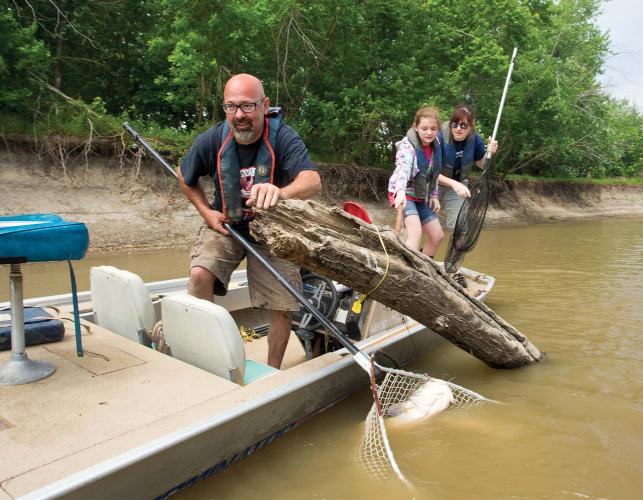

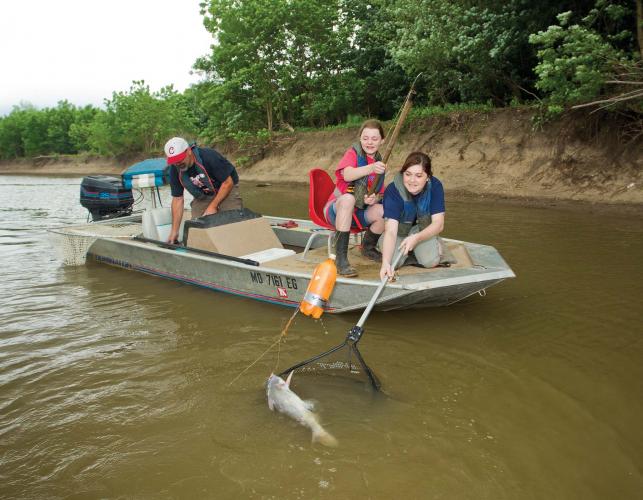
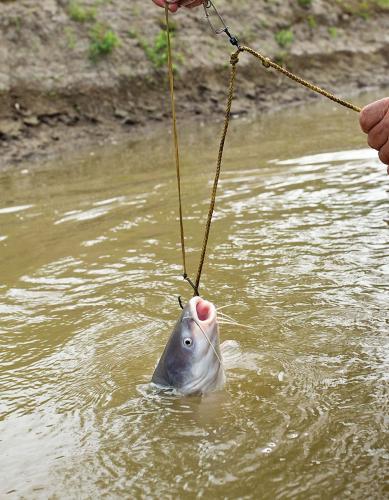
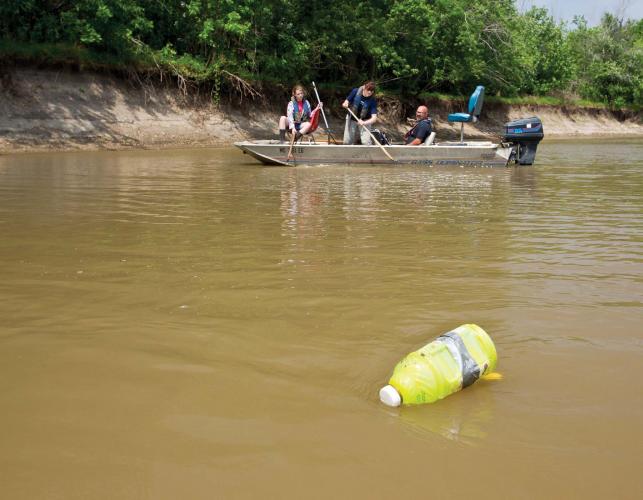
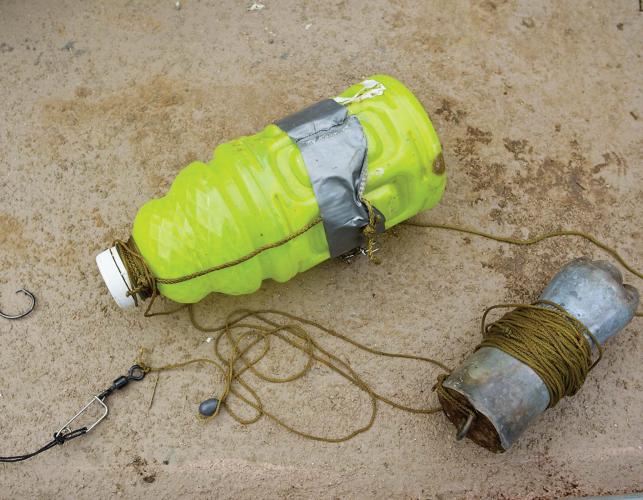
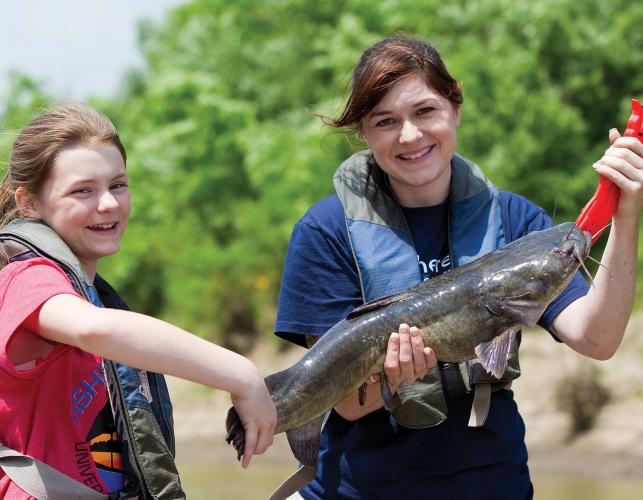
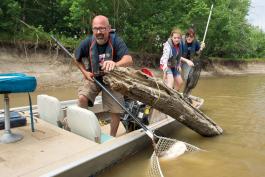

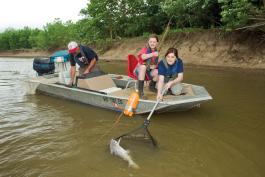
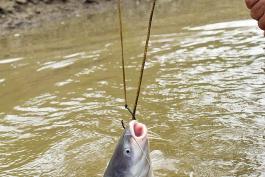


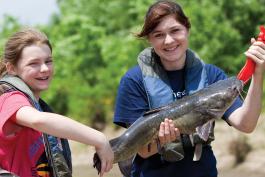
Also In This Issue


And More...
This Issue's Staff
Managing Editor - vacant
Art Director - Cliff White
Staff Writer/Editor - Brett Dufur
Staff Writer - Jim Low
Photographer - Noppadol Paothong
Photographer - David Stonner
Designer - Stephanie Thurber
Circulation - Laura Scheuler






















